| Listing 1 - 10 of 18 | << page >> |
Sort by
|
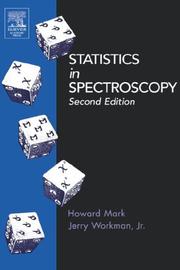
ISBN: 0124725317 9786611119225 1281119229 0080541755 9780124725317 9781281119223 6611119221 9780080541754 Year: 2003 Publisher: Amsterdam: Elsevier,
Abstract | Keywords | Export | Availability | Bookmark
 Loading...
Loading...Choose an application
- Reference Manager
- EndNote
- RefWorks (Direct export to RefWorks)
Statistics in Spectroscopy, Second Edition, is an expanded and updated version of the original title. The aim of the book is to bridge the gap between the average chemist/spectroscopist and the study of statistics. The book introduces the novice reader to the ideas and concepts of statistics and uses spectroscopic examples to show how these concepts are applied. Several key statistical concepts are introduced through the use of computer programs.Serves as a primer for all chemists who need to know more about statistical analysisWritten in a readable style with minimal
Spectrum analysis --- Chemistry, Analytic --- Analysis, Chemical --- Analytic chemistry --- Chemical analysis --- Chemistry --- Analysis, Spectrum --- Spectra --- Spectrochemical analysis --- Spectrochemistry --- Spectrometry --- Spectroscopy --- Interferometry --- Optics --- Radiation --- Wave-motion, Theory of --- Absorption spectra --- Light --- Spectroscope --- Statistical methods. --- Qualitative. --- Qualitative --- Analytical chemistry --- Acqui 2006
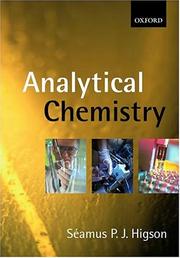
ISBN: 0198502893 9780198502890 Year: 2003 Publisher: Groot-Brittannië Oxford University Press
Abstract | Keywords | Export | Availability | Bookmark
 Loading...
Loading...Choose an application
- Reference Manager
- EndNote
- RefWorks (Direct export to RefWorks)
Basic Sciences. Chemistry --- Chemistry, Analytic. --- Analytical Chemistry. --- 543 --- analytische chemie (scheikunde) --- chemische analyse --- Analysis, Chemical --- Analytical chemistry --- Chemical analysis --- analytische chemie (analytische scheikunde) --- Metallurgical analysis --- Mineralogy, Determinative --- Chemistry, Analytic --- Chemistry Techniques, Analytical --- Analytic chemistry --- Chemistry --- Analytische chemie
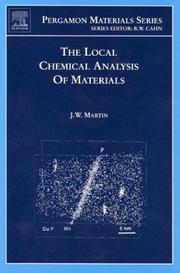
ISBN: 9780080439365 0080439365 9780080535579 0080535577 9786611053963 1281053961 Year: 2003 Publisher: London : Elsevier,
Abstract | Keywords | Export | Availability | Bookmark
 Loading...
Loading...Choose an application
- Reference Manager
- EndNote
- RefWorks (Direct export to RefWorks)
* Expert, up-to-date guidance on the appropriate techniques of local chemical analysis * Comprehensive. This volume is an ideal starting point for material research and development, bringing together a number of techniques usually only found in isolation * Recent examples of the applications of techniques are provided in all cases Helping to solve the problems of materials scientists in academia and industry, this book offers guidance on appropriate techniques of chemical analysis of materials at the local level, down to the atomic scale. Comparisons are made between various
Materials --- Chemistry, Analytic. --- Analysis, Chemical --- Analytic chemistry --- Chemical analysis --- Chemistry, Analytic --- Chemistry --- Analysis. --- 620.18 --- 620.18 Investigation of structure of materials. Metallography. Analogous study of non-metals --- Investigation of structure of materials. Metallography. Analogous study of non-metals
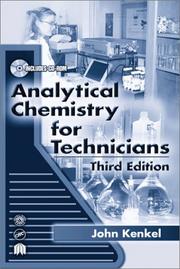
ISBN: 1566705193 9781566705196 Year: 2003 Publisher: Boca Raton Lewis
Abstract | Keywords | Export | Availability | Bookmark
 Loading...
Loading...Choose an application
- Reference Manager
- EndNote
- RefWorks (Direct export to RefWorks)
1. Introduction to analytical science 2. Sampling and sample preparation 3. Gravimetric analysis 4. Introduction to trimetric analysis 5. Applications of trimetric analysis 6. Introduction to instrumental analysis 7. Introduction to spectrochemical methods 8. UV-VIS and IR molecular spectrometry 9. Atomic spectroscopy 10. Other spectroscopic methods 11. Analytical separations 12. Gas chromotography 13. High performance liquid chromatography 14. Electroanalytical methods 15. Physical testing methods 16. Bionalaysis
Analytical chemistry --- spectrometrie --- UV VIS spectrometrie --- GC (gaschromatografie) --- IR spectroscopie --- fysicochemie --- scheidingstechnieken --- biochemie --- analytische chemie --- vloeistofchromotografie --- Chemistry, Analytic. --- Chimie analytique --- Analytische chemie --- 543 --- analytische chemie (scheikunde) --- chromatografie --- instrumentele analyse --- monsterneming (staalname) --- oefeningen --- analytische chemie (analytische scheikunde) --- 543 Analytical chemistry --- Chemistry, Analytic --- Analysis, Chemical --- Chemical analysis --- Metallurgical analysis --- Mineralogy, Determinative --- Analytical chemistry. --- Analytic chemistry --- Chemistry --- GC (gas chromatography)

ISBN: 0471328456 9780471328452 Year: 2003 Volume: 162 Publisher: Hoboken J. Wiley
Abstract | Keywords | Export | Availability | Bookmark
 Loading...
Loading...Choose an application
- Reference Manager
- EndNote
- RefWorks (Direct export to RefWorks)
Analytical chemistry --- Mathematical statistics --- Sampling --- Chemistry, Analytic --- Methodology --- Sampling. --- 543.2 --- analytische chemie (scheikunde) --- chemie (scheikunde) --- chromatografie --- organische verbindingen --- Analysis, Chemical --- Chemical analysis --- Metallurgical analysis --- Mineralogy, Determinative --- Inspection by sampling --- Methodology. --- chemische analysemethoden --- Analytic chemistry --- Chemistry --- Chemistry, Analytic - Methodology --- Acqui 2006 --- Analytische chemie : monstervoorbereiding --- 543
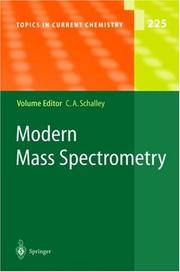
ISSN: 03401022 ISBN: 3540000984 3540361138 9783540000983 Year: 2003 Volume: 225 Publisher: Berlin Springer
Abstract | Keywords | Export | Availability | Bookmark
 Loading...
Loading...Choose an application
- Reference Manager
- EndNote
- RefWorks (Direct export to RefWorks)
Organic chemistry. --- Analytical chemistry. --- Inorganic chemistry. --- Physical chemistry. --- Biochemistry. --- Organic Chemistry. --- Analytical Chemistry. --- Inorganic Chemistry. --- Physical Chemistry. --- Biochemistry, general. --- Biological chemistry --- Chemical composition of organisms --- Organisms --- Physiological chemistry --- Biology --- Chemistry --- Medical sciences --- Chemistry, Theoretical --- Physical chemistry --- Theoretical chemistry --- Inorganic chemistry --- Inorganic compounds --- Analysis, Chemical --- Analytic chemistry --- Chemical analysis --- Chemistry, Analytic --- Organic chemistry --- Composition
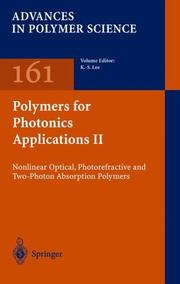
ISBN: 3540423842 3540431578 3540456422 3540446087 Year: 2003 Publisher: Berlin Springer
Abstract | Keywords | Export | Availability | Bookmark
 Loading...
Loading...Choose an application
- Reference Manager
- EndNote
- RefWorks (Direct export to RefWorks)
The future of information technology requires ultra high speed processing and large data storage capacity. Since the electronics technology using semi conduc tors and inorganic materials is about to reach its limits, much current research is focused on utilizing much faster photons than electrons, namely photonics. To achieve any significant effect on the actual use of the science of photonics, devel opments of more efficient photonics materials, better optical property evaluations, manufacture of devices for system applications, etc. are the subjects which need to be explored. In particular, the development of photonics materials stands in the forefront of research as this constitutes the most pertinent factor with regard to the development of ultra high speed and large capacity information processing. In this respect, there has been continuous research on photo responsive materials through molecular structure design and architecture and the results so far are very promising as functions and performances are beginning to realize their high expectations. The two special volumes "Polymers for Photonics Applications" give authorita tive and critical reviews on up to date activities in various fields of photonic poly mers including their promising applications. Seven articles have been contributed by internationally recognized and they deal with, polymers for second and third order nonlinear optics, quadratic parametric interactions in polymer waveguides, electroluminescent polymers as light sources, photoreflective polymers for holo graphic information storage, and highly efficient two photon absorbing organics and polymers.
Photonics. --- Polymers --- Optical properties. --- Polymers . --- Condensed matter. --- Physical chemistry. --- Analytical chemistry. --- Polymer Sciences. --- Condensed Matter Physics. --- Physical Chemistry. --- Analytical Chemistry. --- Analysis, Chemical --- Analytic chemistry --- Chemical analysis --- Chemistry, Analytic --- Chemistry --- Chemistry, Theoretical --- Physical chemistry --- Theoretical chemistry --- Condensed materials --- Condensed media --- Condensed phase --- Materials, Condensed --- Media, Condensed --- Phase, Condensed --- Liquids --- Matter --- Solids --- Polymere --- Polymeride --- Polymers and polymerization --- Macromolecules
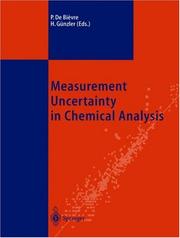
ISBN: 3540439900 9783540439905 3642078842 3662051737 Year: 2003 Publisher: Berlin Springer-Verlag
Abstract | Keywords | Export | Availability | Bookmark
 Loading...
Loading...Choose an application
- Reference Manager
- EndNote
- RefWorks (Direct export to RefWorks)
It is now becoming recognized in the measurement community that it is as important to communicate the uncertainty related to a specific measurement as it is to report the measurement itself. Without knowing the uncertainty, it is impossible for the users of the result to know what confidence can be placed in it; it is also impossible to assess the comparability of different measurements of the same parameter. This volume collects 20 outstanding papers on the topic, mostly published from 1999-2002 in the journal "Accreditation and Quality Assurance." They provide the rationale for why it is important to evaluate and report the uncertainty of a result in a consistent manner. They also describe the concept of uncertainty, the methodology for evaluating uncertainty, and the advantages of using suitable reference materials. Finally, the benefits to both the analytical laboratory and the user of the results are considered.
Analytical chemistry --- Metrology --- Chemistry, Analytic --- Measurement. --- Uncertainty. --- Quantitative. --- Measurement uncertainty (Statistics) --- Basic Sciences. Chemistry --- Analytical Chemistry --- 543 --- analytische chemie (scheikunde) --- chemische analyse --- metingen --- metrologie --- referentiematerialen --- 54.08 --- 543.4 --- Chemische analyse : metingen --- analytische chemie (analytische scheikunde) --- Measurement uncertainty (Statistics). --- Analytical Chemistry. --- Error, Margin of (Statitics) --- Margin of error (Statistics) --- Instrumental variables (Statistics) --- Measurement --- Uncertainty --- Quantitative analysis --- Quantitative chemical analysis --- Quantitative --- Quantitative analytical chemistry --- Analytical chemistry. --- Analysis, Chemical --- Analytic chemistry --- Chemical analysis --- Chemistry --- Chemistry, Analytic - Quantitative.
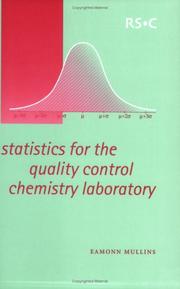
ISBN: 0854046712 Year: 2003 Publisher: Cambridge : Royal Society of Chemistry,
Abstract | Keywords | Export | Availability | Bookmark
 Loading...
Loading...Choose an application
- Reference Manager
- EndNote
- RefWorks (Direct export to RefWorks)
Chemometrics. --- 543 --- 519.873 --- 519.248 --- 519.248 Engineering statistics. Operational research statistics. Queuing theory. Quality control. Reliability etc. --- Engineering statistics. Operational research statistics. Queuing theory. Quality control. Reliability etc. --- 519.873 Theory of reliability and reservation. Quality control --- Theory of reliability and reservation. Quality control --- 543 Analytical chemistry --- Analytical chemistry --- Chemistry, Analytic --- Chemistry --- Statistical methods --- Engineering statistics. Operational research statistics. Queuing theory. Quality control. Reliability etc --- Mathematics --- Measurement --- Analysis, Chemical --- Analytic chemistry --- Chemical analysis
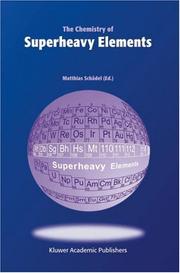
ISBN: 0306484153 1402012500 Year: 2003 Publisher: New York, NY : Springer US : Imprint: Springer,
Abstract | Keywords | Export | Availability | Bookmark
 Loading...
Loading...Choose an application
- Reference Manager
- EndNote
- RefWorks (Direct export to RefWorks)
The Chemistry of the Superheavy Elements provides a complete coverage of the chemistry of a series of elements beginning with atomic number 104 – the transactinide or superheavy elements – including their production in nuclear reactions at heavy-ion accelerators. The contributors to this work include many renowned scientists who, during the last decade, have made vast contributions towards understanding the chemistry of these elusive elements, both experimentally and theoretically. The main emphasis here is on demonstrating the fascinating studies involved in probing the architecture of the periodic table at its uppermost end, where relativistic effects drastically influence chemical properties. All known chemical properties of these elements are described together with the experimental techniques applied to study these short-lived man-made elements one atom at a time. The status of theoretical chemistry and of empirical models is presented as well as aspects of nuclear physics. In addtition, one chapter outlines the meanderings in this field from a historical perspective. This book is a complete and up-to-date source for advanced chemistry students as well as for those who teach chemistry involving the superheavy elements.
Superheavy elements. --- Nuclear chemistry. --- Chemistry, inorganic. --- Chemistry, Physical organic. --- Analytical biochemistry. --- Nuclear physics. --- Nuclear Chemistry. --- Inorganic Chemistry. --- Physical Chemistry. --- Analytical Chemistry. --- Nuclear Physics, Heavy Ions, Hadrons. --- Inorganic chemistry. --- Physical chemistry. --- Analytical chemistry. --- Heavy ions. --- Ions --- Atomic nuclei --- Atoms, Nuclei of --- Nucleus of the atom --- Physics --- Analysis, Chemical --- Analytic chemistry --- Chemical analysis --- Chemistry, Analytic --- Chemistry --- Chemistry, Theoretical --- Physical chemistry --- Theoretical chemistry --- Inorganic chemistry --- Inorganic compounds --- Chemistry, Nuclear --- Chemistry, Physical and theoretical
| Listing 1 - 10 of 18 | << page >> |
Sort by
|

 Search
Search Feedback
Feedback About UniCat
About UniCat  Help
Help News
News